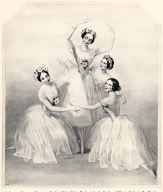Reaching New Heights
Due to the change in notions surrounding the ideal
attributes of masculinity
and femininity , women were able to move into the spotlight in the dance
world. With the introduction of pointe work, the expulsion
of the danseur was complete. As discussed earlier, flat-soled
footwear allowed for
the greater mobility of the dancer. This coupled with the lighter
weight fabrics of dresses allowed for the introduction of greater
acrobatics and the desire to achieve new heights. Legs, released from their
eighteenth-century brocade
bonds, flew higher in kicks, spun more swiftly in pirouettes, and leapt
farther than
before. As well, with disappearance of the high-heeled
shoe, the foot was
returned to its natural standing position, allowing it to enjoy a greater
range of motion: it could arch, stretch and point at the whim of its owner
(as mentioned before, high heels along with thick leather soles would have
restricted the expressive qualities of the foot) (Chazin-Bennahum
1997).
Another development that may have made the transition to pointe work easier
was
the construction
of shoes with squared toes shortly after the Restoration (Personal
Observation),
providing a platform upon which the ballerina could balance herself. The
question
that
needs
to be raised is why did the desire to dance sur la pointe developed at
this time? Once again we will need to shift our attention from the stage
to the outside world.
, women were able to move into the spotlight in the dance
world. With the introduction of pointe work, the expulsion
of the danseur was complete. As discussed earlier, flat-soled
footwear allowed for
the greater mobility of the dancer. This coupled with the lighter
weight fabrics of dresses allowed for the introduction of greater
acrobatics and the desire to achieve new heights. Legs, released from their
eighteenth-century brocade
bonds, flew higher in kicks, spun more swiftly in pirouettes, and leapt
farther than
before. As well, with disappearance of the high-heeled
shoe, the foot was
returned to its natural standing position, allowing it to enjoy a greater
range of motion: it could arch, stretch and point at the whim of its owner
(as mentioned before, high heels along with thick leather soles would have
restricted the expressive qualities of the foot) (Chazin-Bennahum
1997).
Another development that may have made the transition to pointe work easier
was
the construction
of shoes with squared toes shortly after the Restoration (Personal
Observation),
providing a platform upon which the ballerina could balance herself. The
question
that
needs
to be raised is why did the desire to dance sur la pointe developed at
this time? Once again we will need to shift our attention from the stage
to the outside world.